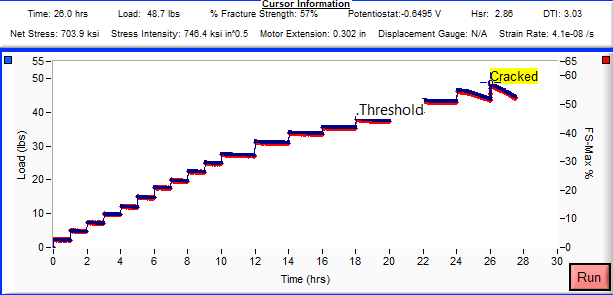Welcome to the Applied Fracture Mechanics blog, where we explore the latest advancements in fracture testing techniques. Today, we're excited to dive into the world of accelerated fracture mechanics and shed light on the game-changing rising step load process. This innovative method enables engineers to achieve rapid and accurate fracture mechanics testing, revolutionizing the way we evaluate material integrity. So, let's embark on a journey where speed and precision converge!
Traditional fracture mechanics tests can be slow, expensive, and difficult. At Applied Fracture Mechanics, we are changing that completely. Using the modern rising step load (RSL) technology, we can provide rapid, easy, and affordable fracture mechanics analysis.
Unleashing the Rising Step Load Process:
Fracture mechanics testing is a critical aspect of engineering, allowing us to understand how materials respond to stress and the potential for cracks to propagate. Traditionally, fracture testing can be a time-consuming process, requiring extensive testing periods to gather accurate data. However, the rising step load process has changed the game by offering a quicker and more precise approach.
The rising step load process involves incrementally increasing the load applied to the material in discrete steps. By carefully designing these load increments, we can rapidly obtain valuable information about crack initiation, crack growth, and overall fracture behavior. This method accelerates the testing timeline without compromising the accuracy and reliability of the results.

Advantages of the Rising Step Load Process:
- Speedy Results: The rising step load process dramatically reduces testing time, allowing engineers to obtain fracture mechanics data in a fraction of the time compared to traditional methods. This acceleration empowers teams to meet tight project deadlines and make prompt decisions regarding material selection and structural design.
- Uncompromised Accuracy: Despite its efficiency, the rising step load process maintains exceptional accuracy. Engineers can confidently rely on the results obtained from this method, as it ensures consistent and reproducible data. This accuracy enables precise comparisons between experiments and facilitates tracking of fracture properties over time.
- Increased Productivity: With the rising step load process, engineers can accomplish more in less time. By swiftly gathering accurate fracture mechanics data, teams can allocate their resources more efficiently and focus on other critical aspects of their projects, ultimately boosting productivity.
- Enhanced Safety Assessments: In industries where safety is paramount, the rising step load process provides engineers with the tools to perform thorough safety assessments. The rapid acquisition of fracture data enables timely identification of potential material vulnerabilities, allowing for proactive measures and ensuring the integrity of critical structures.
Accelerated Testing of Environmental Corrosion and Fracture Mechanics
Accelerated fracture mechanics testing is no longer a distant dream with the rising step load process. By combining speed and accuracy, this innovative method empowers engineers to obtain precise results in record time. Applied Fracture Mechanics is dedicated to delivering the latest advancements in fracture testing techniques, and we're thrilled to introduce you to the rising step load process.
Are you ready to unlock the true potential of accelerated fracture mechanics? Contact us at Applied Fracture Mechanics today and discover how this groundbreaking technique can revolutionize your approach to material evaluation. Our expert team is here to support you in achieving quick, accurate, and reliable results. Together, let's accelerate progress in the world of fracture mechanics!
